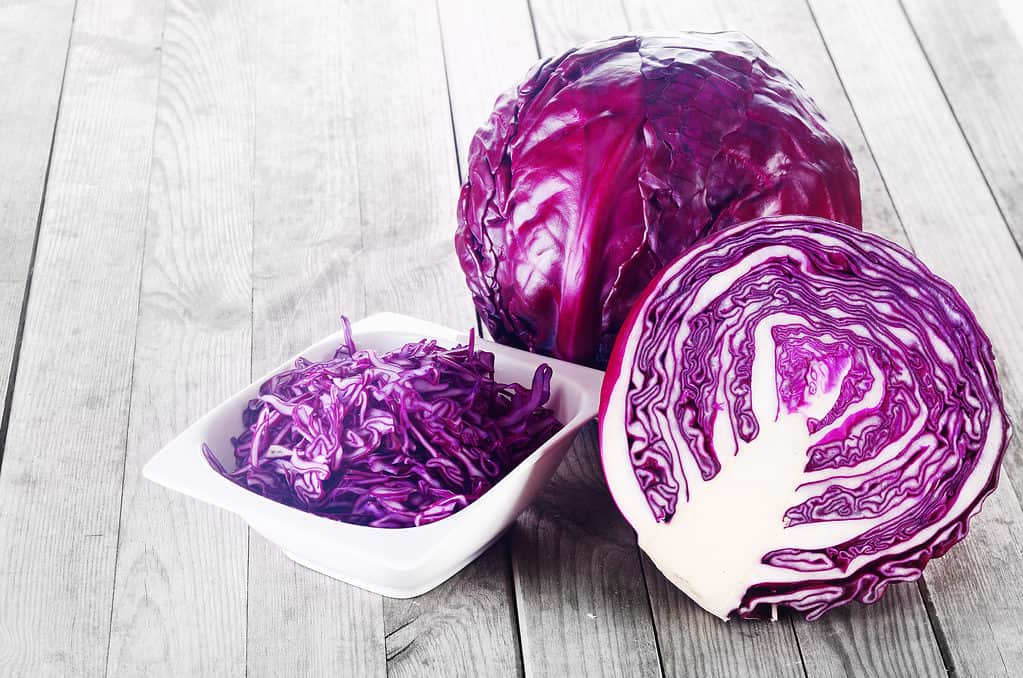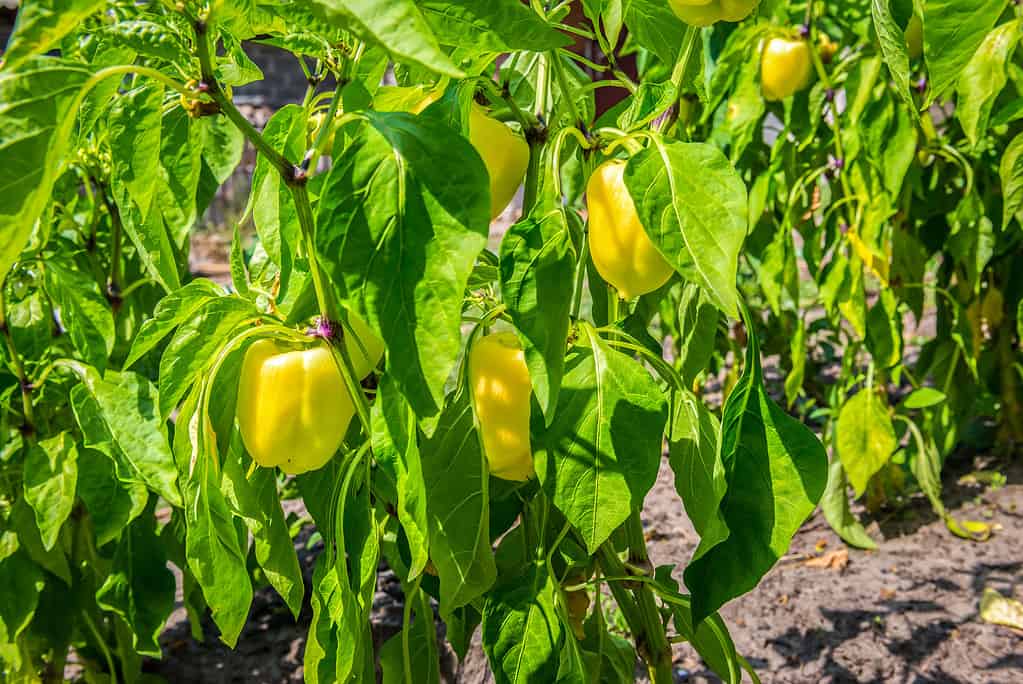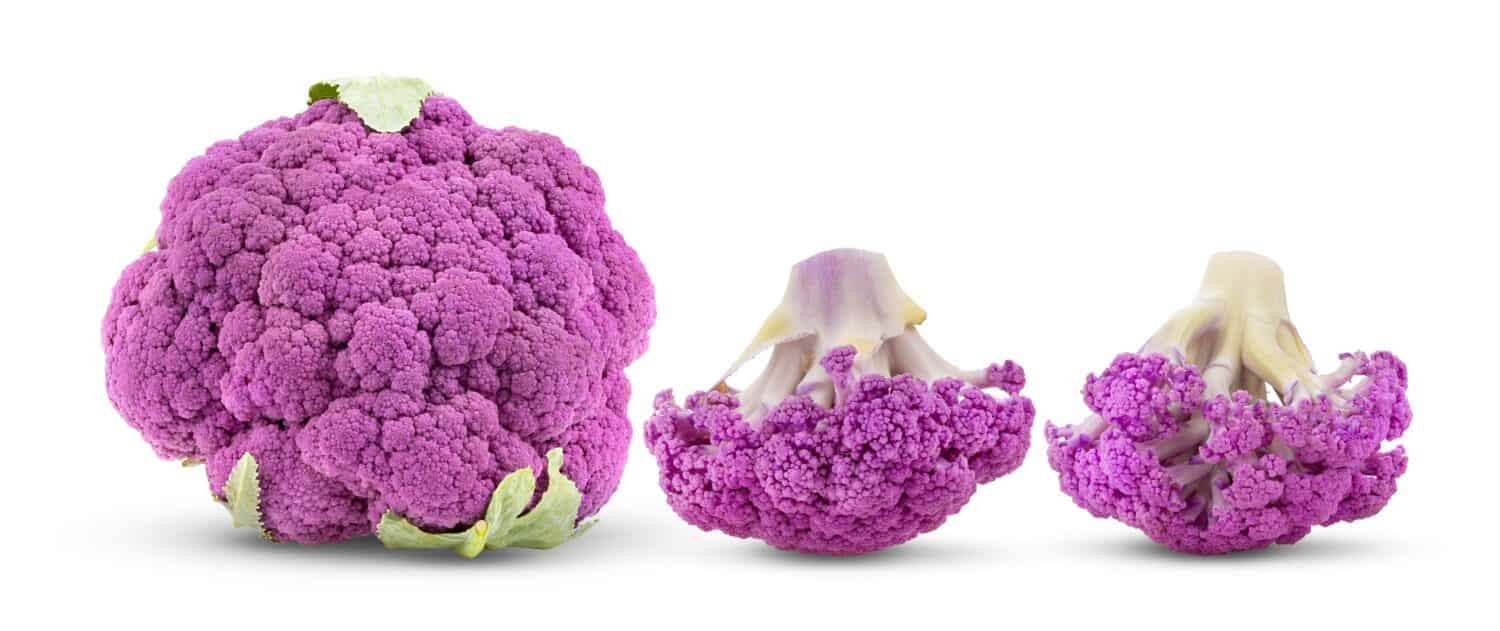Vegetables come in vibrant colors, from rich reds to sunny yellows and vivid purples. While green varieties may be most familiar, exploring the rainbow-colored vegetables of brightly-hued produce can add exciting new flavors, textures, and nutrition to your diet.
In this blog post, we will showcase some of the most colorful and nutrient-dense vegetable varieties nature offers. So, get ready to fill your plate with a tasty spectrum of healthy rainbow-colored vegetables.

Cabbage is one of the delicious red vegetables.
©stockcreations/Shutterstock.com
1. Red Vegetables
Red fruits and veggies are packed with lycopene, an antioxidant that may help reduce the risk of cancer and heart disease.
Tomatoes
From tiny cherry tomatoes to massive heirloom varieties, tomatoes come in various scarlet shades. In addition to lycopene, they contain vitamins A, C, and K. Try sundried tomatoes for a concentrated burst of sweet, red tomato flavor.
Red Cabbage
This vegetable contains anthocyanins, the same pigment that makes blueberries blue. Anthocyanins act as antioxidants in the body. Shred red cabbage for slaws or enjoy its crunch in stir-fries. The leaves also make a colorful natural pH indicator due to their pigmentation.
Red Peppers
Crisp, sweet red bell peppers provide more than triple the vitamin C of an orange. Roast them to bring out their natural sweetness and add them to sandwiches, omelets, and pasta dishes.
Radishes
These root vegetables have an eye-catching scarlet interior beneath their white or pink exterior. Radishes also have a delightfully spicy, peppery bite. Eat them raw with butter or toss sliced radishes into salads.
Beets
From golden beets to ruby red, beets contain betalain pigments with antioxidant and anti-inflammatory effects. Moreover, roasted beets make a delicious, healthy side dish. Blend them into dips or cut into wedges for salads.

Sweet potatoes are ideal for casseroles or as a simple side.
©iStock.com/MahirAtes
2. Orange Vegetables
Orange produce is full of beta-carotene, which the body converts into vitamin A. Additionally, vitamin A supports eye health and immune function.
Carrots
These crunchy root vegetables are likely the first food that comes to mind when you think of orange produce. Carrots are rich in vitamin A, providing more than 200% of the recommended daily intake in just one cup. Enjoy them raw with dip, or add them to soups, stews, and roasted veggie medleys.
Sweet Potatoes
Bake sweet potatoes and top with cinnamon for a creamy, decadent treat. The bold orange flesh indicates high levels of beta-carotene. These fiber-filled spuds are packed with vitamins A and C.
Pumpkin
Pumpkin is a nutritious orange vegetable perfect for fall and is one of the common rainbow-colored vegetables. Its bright color signifies its ample vitamin A content. Furthermore, use pumpkin puree in muffins, quick breads, pancakes, and pies for a nutritional boost.
Butternut Squash
This winter squash variety has pale orange flesh with a mildly sweet, nutty taste similar to pumpkin. Roast chunks of butternut squash to bring out its natural sweetness and soft, creamy texture.

Sweet yellow bell peppers have high vitamin C content.
©iStock.com/Kateryna Kolesnyk
3. Yellow Vegetables
Yellow produce contains zeaxanthin and lutein, two compounds linked to eye health. Stock up on these sunny veggies to safeguard your vision.
Yellow Bell Peppers
Like their red counterparts, yellow peppers deliver ample vitamin C. They have a sweeter, mellower flavor than other colored bell peppers. Add slices to kabobs, stir-fries, pizza, and sandwiches.
Yellow Summer Squash
From golden zucchini to vibrant yellow crookneck squash, yellow summer squash varieties make colorful and tender additions to any meal. Grill, roast, or steam these mild veggies to bring out their best flavor.
Corn
This classic summer vegetable contains zeaxanthin in its yellow kernels. Enjoy corn on the cob slathered in butter, or grill it and sprinkle it with chili powder. Add fresh or frozen corn to salsas, chowders, and fritters.
Yellow Potatoes
Buttery yellow-fleshed potatoes provide potassium and vitamin C in addition to vision-protecting antioxidants. Russet potatoes tend to get all the love, but yellow potatoes roast up deliciously crisp. Try yellow Finn or Yukon gold varieties.
Yellow Tomatoes
In addition to red tomatoes, watch for sunny yellow tomato varieties at your local farmers’ market. Yellow tomatoes have a sweeter, tropical fruit-like flavor. Enjoy them sliced in salads or on sandwiches.

Zucchini plants can produce very large harvests.
©iStock.com/Cineberg
4. Green Vegetables
Green produce is packed with unique health benefits. Additionally, fill half your plate with green veggies for a well-rounded meal.
Broccoli
This green cruciferous vegetable is rich in vitamins C and K and folate. Enjoy it raw with dip or lightly steamed to retain its nutritious compounds. Don’t forget the florets—they’re the most nutritious part!
Green Beans
Grab a handful of freshly picked green beans to munch on raw or lightly steam them. Furthermore, green beans contain antioxidants like kaempferol that may help lower inflammation.
Zucchini
From spiralized “zoodles” to baked zucchini fries, this versatile green veggie is mild in flavor and easily takes on the tastes of sauces and seasonings. Zucchini contains vitamin C, manganese, and omega-3 fatty acids.
Artichokes
Don’t be intimidated by this unusual green vegetable. Boiled or steamed artichoke hearts are worth the effort—peel off the leaves, dip them in melty butter or lemon aioli, and enjoy. Artichokes provide essential antioxidants and prebiotics.
Cucumbers
Crunchy cucumbers have a high water content, making them naturally hydrating. Eat them raw in salads and sandwiches, or add peeled and sliced cucumbers to infused water for flavor. They contain vitamin K, copper, and potassium.

Blue corn has high levels of anthocyanins.
©p_saranya/Shutterstock.com
5. Blue/Indigo Vegetables
These vegetables’ blue and indigo pigments have antioxidant effects linked to reduced risk of chronic illnesses.
Blue Potatoes
With their deep blue skin and flesh, blue potatoes are as nutritious as they are vivid. They contain anthocyanins and antioxidants. Enjoy them roasted, mashed, or boiled.
Blue Corn
Blue corn has a striking indigo color and contains higher levels of anthocyanins than yellow corn. Use blue cornmeal to make flavorful tortillas, breads, and muffins.
Indigo Rose Tomatoes
These unique tomatoes start green and ripen to a dark indigo color. They have a bold tomato flavor with earthy, smoky notes. Try them fresh in salsa or roasted.
Blue Carrots
In addition to orange carrots, watch for stunning blue varieties at farmers’ markets. These contain unique anthocyanin pigments with antioxidant benefits.
Blue Cabbage
Like red cabbage, blue cabbage contains high levels of antioxidant anthocyanins. Thinly slice it to add vibrant color to slaws and salads. It can also be cooked into sweet and tangy braised cabbage dishes.

Purple cauliflower is a versatile rainbow-colored vegetable.
©pukao/Shutterstock.com
6. Purple/Violet Vegetables
The pigments in these vegetables have anti-oxidative properties associated with a lower risk of chronic diseases.
Purple Potatoes
Potatoes are as beneficial as they are pretty. On average, they contain four times the antioxidants of russet potatoes and minerals like iron and potassium.
Purple Carrots
In addition to orange carrots, keep an eye out for stunning purple varieties. Moreover, these contain extra pigments of anthocyanin that have antioxidant effects. Grate into slaws or slice and roast them.
Purple Cauliflower
This vividly-colored cauliflower variety contains the same sulforaphane found in traditional white cauliflower with the addition of anthocyanins. Furthermore, you can enjoy roasted, steamed, or blended into a bright purple cauliflower soup.
Purple Tomatillos
More rare than green tomatillos, purple tomatillos have a sweet, tangy flavor. Their color comes from anthocyanins. Not to mention, you can use their pulp in flavorful homemade salsa.
Purple Broccoli
Purple broccoli contains the same nutrients as traditional green broccoli, with added antioxidant benefits from its anthocyanin pigments. So, when you cook it, the color will get more vivid.
Purple Kohlrabi
Kohlrabi has a turnip-like flavor when eaten raw or roasted. Search for gorgeous purple types and cut them into wedges to relish their color and crunch. It’s also rich in antioxidants.
Eggplant
Eggplants come in various shapes, sizes, and colors, from deep purple to white. Not to mention, their unique flavor is perfect for baba ghanoush, ratatouille, and stir-fries. Also, the skin contains antioxidant pigments.
| Color | Vegetable |
|---|---|
| Red | Tomatoes |
| Red | Red Cabbage |
| Red | Red Peppers |
| Red | Radishes |
| Red | Beets |
| Orange | Carrots |
| Orange | Sweet Potatoes |
| Orange | Pumpkin |
| Orange | Butternut Squash |
| Yellow | Corn |
| Yellow | Yellow Potatoes |
| Yellow | Yellow Tomatoes |
| Green | Broccoli |
| Green | Green Beans |
| Green | Zucchini |
| Green | Artichokes |
| Green | Cucumber |
| Blue/Indigo | Blue Potatoes |
| Blue/Indigo | Blue Corn |
| Blue/Indigo | Indigo Rose Tomatoes |
| Blue/Indigo | Blue Carrots |
| Blue/Indigo | Blue Cabbage |
| Purple | Purple Potatoes |
| Purple | Purple Carrots |
| Purple | Purple Cauliflower |
| Purple | Purple Broccoli |
| Purple | Kohlrabi |
| Purple | Eggplant |
The photo featured at the top of this post is © pukao/Shutterstock.com
Thank you for reading! Have some feedback for us? Contact the AZ Animals editorial team.







